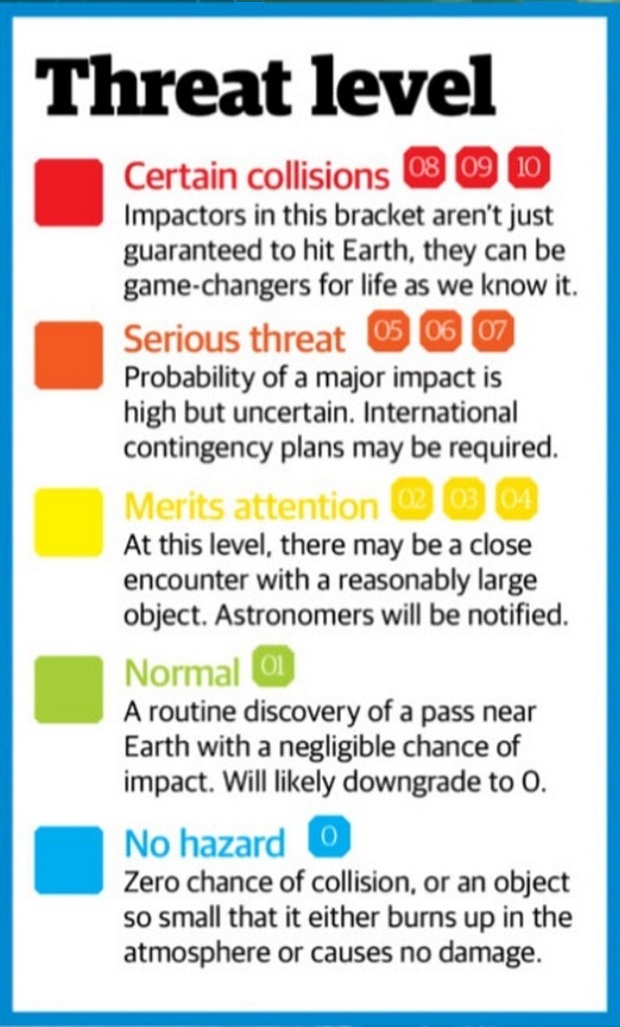Asteroids and comets always pose a threat to collide with planets in the universe. Earth is no exception as well. Our planet has also seen some devastating crashes in the past. One of them supposedly vanquished the dinosaurs from the Earth. The Chelyabinsk incident of 2013 too has raised serious questions about how prepared we are in the event of a major collision in the future. Well, the Torino Scale promises to give us a heads up.
This scale measures the overall threat to Earth of impact from asteroids and other near-Earth objects. Calculating whether an asteroid, comet or other object is going to hit Earth from outer space is more complicated than you might think. It isn’t just a matter of detecting the object and its velocity through space, working its trajectory out. Then putting the two together and seeing if this sets it on a collision course with Earth.
Astronomers will ask a number of questions like : if we think it will collide, when is its estimated date of collision? How much deviation is there in our calculations? Is it possible that, in the time between now and the estimated impact date, something will happen to send it off our calculated course?
Global space agencies like to add other factors to the equation, like the mass of the asteroid and how long it’s going to take to reach Earth. If a relatively tiny asteroid with a mass of ten kilograms (22 pounds) is going to hit Earth within the next hour, the governments of the world are hardly going to run to their bunkers. Similarly, if a ten-kilometre (6.2-mile) wide, Chicxulub-mass comet is likely to impact Earth 500 years from now and cause a catastrophe of global proportions, no-one’s going to sweat that much (for now), either.

The Torino Scale is an accessible, visual version of more scientific impact hazard scales. It distills data from objects in space down to a zero-to-ten scale of their threat to Earth, then grades that scale into five distinct bands. A zero (blue) rating indicates an object that has no chance of hitting Earth or is so small its impact will be hardly noticed. By contrast, an object with a rating of eight, nine or ten (red) is not only certain to hit the Earth, it has a high chance of widespread devastation and may even cause catastrophic global environmental changes.
The first draft of the scale was created by the Massachusetts Institute of Technology’s professor of planetary sciences. Richard Binzel, in 1995. At the time, it was called a ‘Near-Earth Object Hazard Index’. Its name changed to the Torino Impact Hazard Scale in 1999 after the scale was revised at a conference on near-Earth objects in Turin, Italy (Torino in Italian). After about of sensational press coverage over big asteroids with a very low probability of hitting Earth, its categories were renamed and their details revised again, resulting in the Torino Scale that we have today.
Although the scale rates up to a threat level of ten, objects of that apocalyptic nature come along once in every 100,000 years or more. And a level eight – a certain impact capable of flattening many square miles – might come along once every millennium or so. In actual fact, scientists don’t bother doing anything until level three, when other astronomers are alerted to the potential risk. We only really need to start to be concerned when a near-Earth object is graded level five or higher.
So what’s the highest grading we’ve given so far, out of all the thousands of asteroid and comets rated since the Torino Scale was invented? That record goes to 99942 Apophis. A worryingly large asteroid 325 metres (1.066 feet) in diameter capable of widespread destruction… if it were to hit Earth.
It briefly scored a four on the Torino scale in 2004. Before being downgraded to a one after further calculation. Apophis is a near-Earth object with an orbital path that frequently takes it close to Earth, but all the same, scientists put the odds of a near-future impact with this asteroid in the millions if not billions to one. Of course, this low probability effectively makes it a zero on the Torino Scale.
Even though the Torino Scale can only give us the information of the potential impacts which could occur in less than 100 years in the future, we should have sufficient time to prepare ourselves.
-end-


































